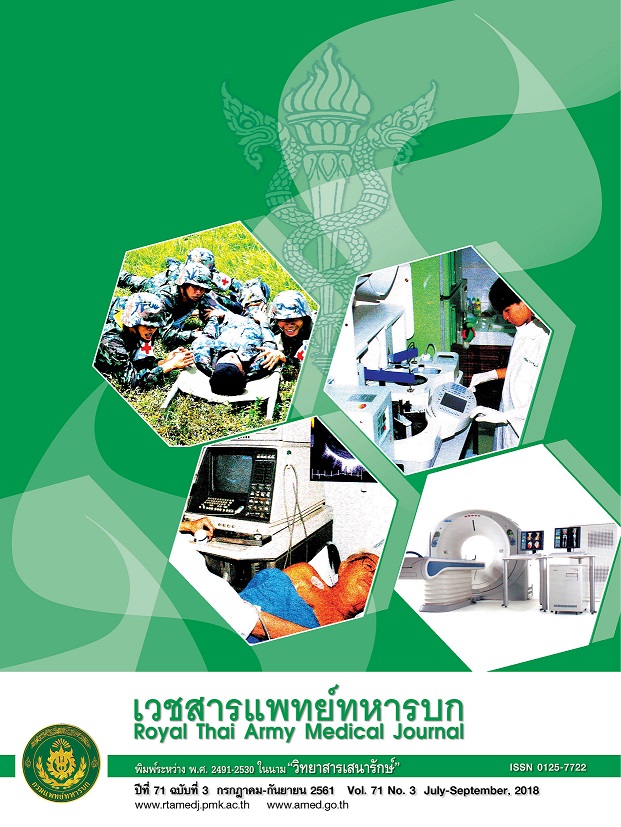Military Tourniquet
Main Article Content
Article Details
Section
บทความฟื้นวิชา (Subject Review)
References
Mabry RL, Holcomb JB, Baker AM, Cloonan CC, Uhorchak JM, Perkins DE, et al. United States Army Rangers in Somalia: an analysis of combat casualties on an urban battlefield. J Trauma. 2000;49:515-28; discussion 28-9.
Holcomb J, Caruso J, McMullin N, Wade CE, Pearse L, Oetjen-Gerdes L, et al. Causes of death in US Special Operations Forces in the global war on terrorism: 2001-2004. US Army Med Dep J. 2007:24-37.
Kelly JF, Ritenour AE, McLaughlin DF, Bagg KA, Apodaca AN, Mallak CT, et al. Injury severity and causes of death from Operation Iraqi Freedom and Operation Enduring Freedom: 2003-2004 versus 2006. J Trauma. 2008;64(2 Suppl):S21-6; discussion S6-7.
Mawhinney AC, Kirk SJ. A systematic review of the use of tourniquets and topical haemostatic agents in conflicts in Afghanistan and Iraq. J R Nav Med Serv. 2015;101:147-54.
Butler FK, Jr., Blackbourne LH. Battlefield trauma care then and now: a decade of Tactical Combat Casualty Care. J Trauma Acute Care Surg. 2012;73(6 Suppl 5):S395-402.
Butler FK. Two Decades of Saving Lives on the Battlefield: Tactical Combat Casualty Care Turns 20. Mil Med. 2017;182:e1563-e8.
Kragh JF, Jr., Walters TJ, Baer DG, Fox CJ, Wade CE, Salinas J, et al. Practical use of emergency tourniquets to stop bleeding in major limb trauma. J Trauma. 2008;64(2 Suppl):S38-49; discussion S-50.
Kragh JF, Jr., Walters TJ, Baer DG, Fox CJ, Wade CE, Salinas J, et al. Survival with emergency tourniquet use to stop bleeding in major limb trauma. Ann Surg. 2009;249:1-7.
Kauvar DS, Miller D, Walters TJ. Tourniquet use is not associated with limb loss following military lower extremity arterial trauma. J Trauma Acute Care Surg. 2018;85:495-9.
Kotwal RS, Butler FK, Gross KR, Kheirabadi BS, Baer DG, Dubick MA, et al. Management of Junctional Hemorrhage in Tactical Combat Casualty Care: TCCC Guidelines? Proposed Change 13-03. J Spec Oper Med. 2013;13:85-93.
Fletcher IR, Healy TE. The arterial tourniquet. Ann R Coll Surg Engl. 1983;65:409-17.
Wenke JC, Walters TJ, Greydanus DJ, Pusateri AE, Convertino VA. Physiological evaluation of the U.S. Army one-handed tourniquet. Mil Med. 2005;170:776-81.
Ruterbusch VL SM, Montgomery LD, Hopper KW, Gerth WA, ONR/MARCORSYSCOM. Evaluation of Self-Applied Tourniquets for Combat Applications. NEDU TR 05-15, Navy Experimental Diving Unit. 2005.
Wall PL, Duevel DC, Hassan MB, Welander JD, Sahr SM, Buising CM. Tourniquets and occlusion: the pressure of design. Mil Med. 2013;178:578-87.
Walters TJ, Wenke JC, Kauvar DS, McManus JG, Holcomb JB, Baer DG. Effectiveness of self-applied tourniquets in human volunteers. Prehosp Emerg Care. 2005;9:416-22.
Hill JP ML, Hopper KW, Roy LA. Evaluation of Self-Applied Tourniquets for Combat Applications, Second Phase. NEDU TR 07-07, Navy Experimental Diving Unit. 2007.
Kragh JF, Jr., Moore VK, 3rd, Aden JK, 3rd, Parsons DL, Dubick MA. Short Report Comparing Generation 6 Versus Prototype Generation 7 Combat Application Tourniquet(R) in a Manikin Hemorrhage Model. J Spec Oper Med. 2016;16:14-7.
Holcomb J, Caruso J, McMullin N, Wade CE, Pearse L, Oetjen-Gerdes L, et al. Causes of death in US Special Operations Forces in the global war on terrorism: 2001-2004. US Army Med Dep J. 2007:24-37.
Kelly JF, Ritenour AE, McLaughlin DF, Bagg KA, Apodaca AN, Mallak CT, et al. Injury severity and causes of death from Operation Iraqi Freedom and Operation Enduring Freedom: 2003-2004 versus 2006. J Trauma. 2008;64(2 Suppl):S21-6; discussion S6-7.
Mawhinney AC, Kirk SJ. A systematic review of the use of tourniquets and topical haemostatic agents in conflicts in Afghanistan and Iraq. J R Nav Med Serv. 2015;101:147-54.
Butler FK, Jr., Blackbourne LH. Battlefield trauma care then and now: a decade of Tactical Combat Casualty Care. J Trauma Acute Care Surg. 2012;73(6 Suppl 5):S395-402.
Butler FK. Two Decades of Saving Lives on the Battlefield: Tactical Combat Casualty Care Turns 20. Mil Med. 2017;182:e1563-e8.
Kragh JF, Jr., Walters TJ, Baer DG, Fox CJ, Wade CE, Salinas J, et al. Practical use of emergency tourniquets to stop bleeding in major limb trauma. J Trauma. 2008;64(2 Suppl):S38-49; discussion S-50.
Kragh JF, Jr., Walters TJ, Baer DG, Fox CJ, Wade CE, Salinas J, et al. Survival with emergency tourniquet use to stop bleeding in major limb trauma. Ann Surg. 2009;249:1-7.
Kauvar DS, Miller D, Walters TJ. Tourniquet use is not associated with limb loss following military lower extremity arterial trauma. J Trauma Acute Care Surg. 2018;85:495-9.
Kotwal RS, Butler FK, Gross KR, Kheirabadi BS, Baer DG, Dubick MA, et al. Management of Junctional Hemorrhage in Tactical Combat Casualty Care: TCCC Guidelines? Proposed Change 13-03. J Spec Oper Med. 2013;13:85-93.
Fletcher IR, Healy TE. The arterial tourniquet. Ann R Coll Surg Engl. 1983;65:409-17.
Wenke JC, Walters TJ, Greydanus DJ, Pusateri AE, Convertino VA. Physiological evaluation of the U.S. Army one-handed tourniquet. Mil Med. 2005;170:776-81.
Ruterbusch VL SM, Montgomery LD, Hopper KW, Gerth WA, ONR/MARCORSYSCOM. Evaluation of Self-Applied Tourniquets for Combat Applications. NEDU TR 05-15, Navy Experimental Diving Unit. 2005.
Wall PL, Duevel DC, Hassan MB, Welander JD, Sahr SM, Buising CM. Tourniquets and occlusion: the pressure of design. Mil Med. 2013;178:578-87.
Walters TJ, Wenke JC, Kauvar DS, McManus JG, Holcomb JB, Baer DG. Effectiveness of self-applied tourniquets in human volunteers. Prehosp Emerg Care. 2005;9:416-22.
Hill JP ML, Hopper KW, Roy LA. Evaluation of Self-Applied Tourniquets for Combat Applications, Second Phase. NEDU TR 07-07, Navy Experimental Diving Unit. 2007.
Kragh JF, Jr., Moore VK, 3rd, Aden JK, 3rd, Parsons DL, Dubick MA. Short Report Comparing Generation 6 Versus Prototype Generation 7 Combat Application Tourniquet(R) in a Manikin Hemorrhage Model. J Spec Oper Med. 2016;16:14-7.

